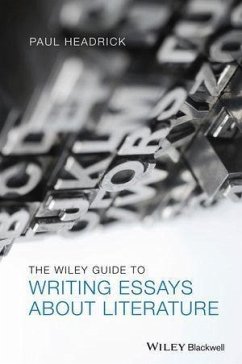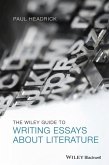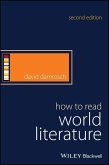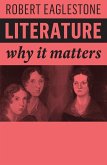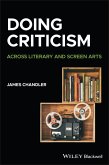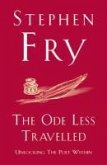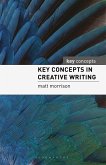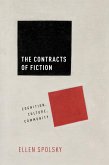Paul Headrick
The Wiley Guide to Writing Essays About Literature (eBook, ePUB)
27,99 €
27,99 €
inkl. MwSt.
Sofort per Download lieferbar

0 °P sammeln
27,99 €
Als Download kaufen

27,99 €
inkl. MwSt.
Sofort per Download lieferbar

0 °P sammeln
Jetzt verschenken
Alle Infos zum eBook verschenken
27,99 €
inkl. MwSt.
Sofort per Download lieferbar
Alle Infos zum eBook verschenken

0 °P sammeln
Paul Headrick
The Wiley Guide to Writing Essays About Literature (eBook, ePUB)
- Format: ePub
- Merkliste
- Auf die Merkliste
- Bewerten Bewerten
- Teilen
- Produkt teilen
- Produkterinnerung
- Produkterinnerung

Bitte loggen Sie sich zunächst in Ihr Kundenkonto ein oder registrieren Sie sich bei
bücher.de, um das eBook-Abo tolino select nutzen zu können.
Hier können Sie sich einloggen
Hier können Sie sich einloggen
Sie sind bereits eingeloggt. Klicken Sie auf 2. tolino select Abo, um fortzufahren.

Bitte loggen Sie sich zunächst in Ihr Kundenkonto ein oder registrieren Sie sich bei bücher.de, um das eBook-Abo tolino select nutzen zu können.
This outstanding practical guide to writing analytical essays on literature develops interpretive skills through focused exercises and modeled examples. The program is tailored to meet the specific needs of beginning undergraduates. * Features unique, detailed guidance on paragraph structure * Includes sample essays throughout to model each stage of the essay-writing process * Focused exercises develop the techniques outlined in each chapter * Dedicated checklists enable quick, accurate assessment by teachers and students * Enhanced glossary with advice on usage added to core definitions
- Geräte: eReader
- mit Kopierschutz
- eBook Hilfe
- Größe: 0.81MB
Andere Kunden interessierten sich auch für
![The Wiley Guide to Writing Essays About Literature (eBook, PDF) The Wiley Guide to Writing Essays About Literature (eBook, PDF)]() Paul HeadrickThe Wiley Guide to Writing Essays About Literature (eBook, PDF)27,99 €
Paul HeadrickThe Wiley Guide to Writing Essays About Literature (eBook, PDF)27,99 €![How to Read World Literature (eBook, ePUB) How to Read World Literature (eBook, ePUB)]() David DamroschHow to Read World Literature (eBook, ePUB)24,99 €
David DamroschHow to Read World Literature (eBook, ePUB)24,99 €![Literature (eBook, ePUB) Literature (eBook, ePUB)]() Robert EaglestoneLiterature (eBook, ePUB)10,99 €
Robert EaglestoneLiterature (eBook, ePUB)10,99 €![Doing Criticism (eBook, ePUB) Doing Criticism (eBook, ePUB)]() James ChandlerDoing Criticism (eBook, ePUB)51,99 €
James ChandlerDoing Criticism (eBook, ePUB)51,99 €![The Ode Less Travelled (eBook, ePUB) The Ode Less Travelled (eBook, ePUB)]() Stephen FryThe Ode Less Travelled (eBook, ePUB)10,99 €
Stephen FryThe Ode Less Travelled (eBook, ePUB)10,99 €![Key Concepts in Creative Writing (eBook, ePUB) Key Concepts in Creative Writing (eBook, ePUB)]() Matthew MorrisonKey Concepts in Creative Writing (eBook, ePUB)26,95 €
Matthew MorrisonKey Concepts in Creative Writing (eBook, ePUB)26,95 €![Contracts of Fiction (eBook, ePUB) Contracts of Fiction (eBook, ePUB)]() Ellen SpolskyContracts of Fiction (eBook, ePUB)24,95 €
Ellen SpolskyContracts of Fiction (eBook, ePUB)24,95 €-
-
-
This outstanding practical guide to writing analytical essays on literature develops interpretive skills through focused exercises and modeled examples. The program is tailored to meet the specific needs of beginning undergraduates. * Features unique, detailed guidance on paragraph structure * Includes sample essays throughout to model each stage of the essay-writing process * Focused exercises develop the techniques outlined in each chapter * Dedicated checklists enable quick, accurate assessment by teachers and students * Enhanced glossary with advice on usage added to core definitions
Dieser Download kann aus rechtlichen Gründen nur mit Rechnungsadresse in D ausgeliefert werden.
Produktdetails
- Produktdetails
- Verlag: John Wiley & Sons
- Erscheinungstermin: 1. August 2013
- Englisch
- ISBN-13: 9781118571507
- Artikelnr.: 39477793
- Verlag: John Wiley & Sons
- Erscheinungstermin: 1. August 2013
- Englisch
- ISBN-13: 9781118571507
- Artikelnr.: 39477793
- Herstellerkennzeichnung Die Herstellerinformationen sind derzeit nicht verfügbar.
Paul Headrick teaches English at Langara College in Vancouver, Canada. He is a published novelist and short story writer whose works include That Tune Clutches My Heart (2008) and a volume of short stories, The Doctrine of Affections (2010).
Preface ix
Acknowledgments xi
Chapter 1 Audience and the Literary Analysis Essay 1
The Importance of Audience 1
The Audience for the Literary Analysis Essay 2
Exercise Set 1.1 Understanding Audience 7
Chapter 2 Analytical Paragraphs 9
Initial Analysis 9
Analytical Paragraphs and Their Three Components 10
Claims 10
Exercise Set 2.1 Identifying Claims 13
Evidence 14
Exercise Set 2.2 Presenting Evidence 14
Analysis 15
Common Problems in Analytical Paragraphs 18
Awkward repetition 18
Confusion about what makes meaning 19
Working with Analytical Paragraphs 20
A sample analytical paragraph 20
Exercise Set 2.3 Understanding Analytical
Paragraphs 20
Exercise Set 2.4 Creating Analytical Paragraphs 21
Integrating Quotations from Literary Texts 24
Guidelines for integrating quotations 24
Exercise Set 2.5 Integrating Quotations 28
Chapter 3 Theme 31
Defining Theme 32
Debating Theme 34
Debating with the text: agreeing and disagreeing with themes 34
Debating about texts: agreeing and disagreeing about themes 35
Identifying Themes 36
Identifying themes in drama and prose fiction 36
Identifying themes in poetry 38
Identifying complex themes 44
Effective Statements of Theme 45
A checklist for effective statements of theme 45
Exercise Set 3.1 Identifying Statements of Theme 48
Chapter 4 Argument Structure 51
The Difference between a Logical Sequence and a List 51
Sample outlines 53
Exercise Set 4.1 Understanding Argument
Structure 55
Organizational Paragraphs and Titles 56
Introductory paragraphs 56
Working with introductory paragraphs 58
Exercise Set 4.2 Understanding Introductory
Paragraphs 59
Transitional paragraphs 60
Working with transitional paragraphs 60
Exercise Set 4.3 Understanding Transitional Paragraphs 61
Concluding paragraphs 61
Working with concluding paragraphs 62
Exercise Set 4.4 Understanding Concluding Paragraphs 63
Titles 63
Exercise Set 4.5 Understanding Titles 64
Chapter 5 Types of Literary Analysis Essays 67
Close Readings 67
Passage Analysis Essays 70
Introductions to passage analysis essays 70
The structure of passage analysis essays 71
Working with passage analysis essays 72
Exercise Set 5.1 Understanding Passage
Analysis Essay Structure 72
Comparative Literary Analysis Essays 73
The purpose of comparative literary analysis essays 73
Introductions to comparative literary analysis essays 74
The structure of comparative literary analysis essays 75
Working with comparative literary analysis essays 75
Exercise Set 5.2 Understanding Comparative
Literary Analysis Essays 76
Literary Analysis Research Essays 77
Literary analysis research essays using critical sources 77
Introductions to literary analysis research essays using critical sources
85
Working with critical sources 85
Exercise Set 5.3 Understanding the Use of Critical Sources 85
Literary analysis research essays using historical sources 87
Working with historical sources 89
Exercise Set 5.4 Understanding the Use of Historical Sources 89
In-Class Essays 90
Appendix 1 MLA Format 93
The Appearance of the Essay 93
Documentation: Works Cited List 94
Works cited entries: print sources 94
Works cited entries: online sources 98
Works cited entries: other non-print sources 99
Documentation: In-Text Citations 99
Formatting Quotations 101
Short quotations 101
Long quotations 102
Changing quotations 103
Appendix 2 Sample Essays 105
1 A Literary Analysis Essay on a Short Story 106
2 A Literary Analysis Essay on a Poem 109
3 A Literary Analysis Essay on a Play 111
4 A Literary Analysis Essay on a Novel 115
5 A Literary Analysis Essay on a Film 119
6 A Passage Analysis Essay 123
7 A Comparative Literary Analysis Essay 126
8 A Literary Analysis Research Essay Using Critical
Sources 130
9 A Literary Analysis Research Essay Using Historical Sources 137
Appendix 3 "The Yellow Wallpaper," by Charlotte Perkins Gilman 141
Appendix 4 Selected Exercise Answers 157
Appendix 5 Glossary of Literary Terms 165
Appendix 6 Structure and Mechanics: Marking Abbreviations for Instructors
and Peer Evaluators 183
Titles 183
Introductory Paragraphs 183
Thesis Statements 183
Analytical Paragraphs 184
Integrating Quotations 184
Index 187
Structure and Mechanics Checklist 195
Acknowledgments xi
Chapter 1 Audience and the Literary Analysis Essay 1
The Importance of Audience 1
The Audience for the Literary Analysis Essay 2
Exercise Set 1.1 Understanding Audience 7
Chapter 2 Analytical Paragraphs 9
Initial Analysis 9
Analytical Paragraphs and Their Three Components 10
Claims 10
Exercise Set 2.1 Identifying Claims 13
Evidence 14
Exercise Set 2.2 Presenting Evidence 14
Analysis 15
Common Problems in Analytical Paragraphs 18
Awkward repetition 18
Confusion about what makes meaning 19
Working with Analytical Paragraphs 20
A sample analytical paragraph 20
Exercise Set 2.3 Understanding Analytical
Paragraphs 20
Exercise Set 2.4 Creating Analytical Paragraphs 21
Integrating Quotations from Literary Texts 24
Guidelines for integrating quotations 24
Exercise Set 2.5 Integrating Quotations 28
Chapter 3 Theme 31
Defining Theme 32
Debating Theme 34
Debating with the text: agreeing and disagreeing with themes 34
Debating about texts: agreeing and disagreeing about themes 35
Identifying Themes 36
Identifying themes in drama and prose fiction 36
Identifying themes in poetry 38
Identifying complex themes 44
Effective Statements of Theme 45
A checklist for effective statements of theme 45
Exercise Set 3.1 Identifying Statements of Theme 48
Chapter 4 Argument Structure 51
The Difference between a Logical Sequence and a List 51
Sample outlines 53
Exercise Set 4.1 Understanding Argument
Structure 55
Organizational Paragraphs and Titles 56
Introductory paragraphs 56
Working with introductory paragraphs 58
Exercise Set 4.2 Understanding Introductory
Paragraphs 59
Transitional paragraphs 60
Working with transitional paragraphs 60
Exercise Set 4.3 Understanding Transitional Paragraphs 61
Concluding paragraphs 61
Working with concluding paragraphs 62
Exercise Set 4.4 Understanding Concluding Paragraphs 63
Titles 63
Exercise Set 4.5 Understanding Titles 64
Chapter 5 Types of Literary Analysis Essays 67
Close Readings 67
Passage Analysis Essays 70
Introductions to passage analysis essays 70
The structure of passage analysis essays 71
Working with passage analysis essays 72
Exercise Set 5.1 Understanding Passage
Analysis Essay Structure 72
Comparative Literary Analysis Essays 73
The purpose of comparative literary analysis essays 73
Introductions to comparative literary analysis essays 74
The structure of comparative literary analysis essays 75
Working with comparative literary analysis essays 75
Exercise Set 5.2 Understanding Comparative
Literary Analysis Essays 76
Literary Analysis Research Essays 77
Literary analysis research essays using critical sources 77
Introductions to literary analysis research essays using critical sources
85
Working with critical sources 85
Exercise Set 5.3 Understanding the Use of Critical Sources 85
Literary analysis research essays using historical sources 87
Working with historical sources 89
Exercise Set 5.4 Understanding the Use of Historical Sources 89
In-Class Essays 90
Appendix 1 MLA Format 93
The Appearance of the Essay 93
Documentation: Works Cited List 94
Works cited entries: print sources 94
Works cited entries: online sources 98
Works cited entries: other non-print sources 99
Documentation: In-Text Citations 99
Formatting Quotations 101
Short quotations 101
Long quotations 102
Changing quotations 103
Appendix 2 Sample Essays 105
1 A Literary Analysis Essay on a Short Story 106
2 A Literary Analysis Essay on a Poem 109
3 A Literary Analysis Essay on a Play 111
4 A Literary Analysis Essay on a Novel 115
5 A Literary Analysis Essay on a Film 119
6 A Passage Analysis Essay 123
7 A Comparative Literary Analysis Essay 126
8 A Literary Analysis Research Essay Using Critical
Sources 130
9 A Literary Analysis Research Essay Using Historical Sources 137
Appendix 3 "The Yellow Wallpaper," by Charlotte Perkins Gilman 141
Appendix 4 Selected Exercise Answers 157
Appendix 5 Glossary of Literary Terms 165
Appendix 6 Structure and Mechanics: Marking Abbreviations for Instructors
and Peer Evaluators 183
Titles 183
Introductory Paragraphs 183
Thesis Statements 183
Analytical Paragraphs 184
Integrating Quotations 184
Index 187
Structure and Mechanics Checklist 195
Preface ix
Acknowledgments xi
Chapter 1 Audience and the Literary Analysis Essay 1
The Importance of Audience 1
The Audience for the Literary Analysis Essay 2
Exercise Set 1.1 Understanding Audience 7
Chapter 2 Analytical Paragraphs 9
Initial Analysis 9
Analytical Paragraphs and Their Three Components 10
Claims 10
Exercise Set 2.1 Identifying Claims 13
Evidence 14
Exercise Set 2.2 Presenting Evidence 14
Analysis 15
Common Problems in Analytical Paragraphs 18
Awkward repetition 18
Confusion about what makes meaning 19
Working with Analytical Paragraphs 20
A sample analytical paragraph 20
Exercise Set 2.3 Understanding Analytical
Paragraphs 20
Exercise Set 2.4 Creating Analytical Paragraphs 21
Integrating Quotations from Literary Texts 24
Guidelines for integrating quotations 24
Exercise Set 2.5 Integrating Quotations 28
Chapter 3 Theme 31
Defining Theme 32
Debating Theme 34
Debating with the text: agreeing and disagreeing with themes 34
Debating about texts: agreeing and disagreeing about themes 35
Identifying Themes 36
Identifying themes in drama and prose fiction 36
Identifying themes in poetry 38
Identifying complex themes 44
Effective Statements of Theme 45
A checklist for effective statements of theme 45
Exercise Set 3.1 Identifying Statements of Theme 48
Chapter 4 Argument Structure 51
The Difference between a Logical Sequence and a List 51
Sample outlines 53
Exercise Set 4.1 Understanding Argument
Structure 55
Organizational Paragraphs and Titles 56
Introductory paragraphs 56
Working with introductory paragraphs 58
Exercise Set 4.2 Understanding Introductory
Paragraphs 59
Transitional paragraphs 60
Working with transitional paragraphs 60
Exercise Set 4.3 Understanding Transitional Paragraphs 61
Concluding paragraphs 61
Working with concluding paragraphs 62
Exercise Set 4.4 Understanding Concluding Paragraphs 63
Titles 63
Exercise Set 4.5 Understanding Titles 64
Chapter 5 Types of Literary Analysis Essays 67
Close Readings 67
Passage Analysis Essays 70
Introductions to passage analysis essays 70
The structure of passage analysis essays 71
Working with passage analysis essays 72
Exercise Set 5.1 Understanding Passage
Analysis Essay Structure 72
Comparative Literary Analysis Essays 73
The purpose of comparative literary analysis essays 73
Introductions to comparative literary analysis essays 74
The structure of comparative literary analysis essays 75
Working with comparative literary analysis essays 75
Exercise Set 5.2 Understanding Comparative
Literary Analysis Essays 76
Literary Analysis Research Essays 77
Literary analysis research essays using critical sources 77
Introductions to literary analysis research essays using critical sources
85
Working with critical sources 85
Exercise Set 5.3 Understanding the Use of Critical Sources 85
Literary analysis research essays using historical sources 87
Working with historical sources 89
Exercise Set 5.4 Understanding the Use of Historical Sources 89
In-Class Essays 90
Appendix 1 MLA Format 93
The Appearance of the Essay 93
Documentation: Works Cited List 94
Works cited entries: print sources 94
Works cited entries: online sources 98
Works cited entries: other non-print sources 99
Documentation: In-Text Citations 99
Formatting Quotations 101
Short quotations 101
Long quotations 102
Changing quotations 103
Appendix 2 Sample Essays 105
1 A Literary Analysis Essay on a Short Story 106
2 A Literary Analysis Essay on a Poem 109
3 A Literary Analysis Essay on a Play 111
4 A Literary Analysis Essay on a Novel 115
5 A Literary Analysis Essay on a Film 119
6 A Passage Analysis Essay 123
7 A Comparative Literary Analysis Essay 126
8 A Literary Analysis Research Essay Using Critical
Sources 130
9 A Literary Analysis Research Essay Using Historical Sources 137
Appendix 3 "The Yellow Wallpaper," by Charlotte Perkins Gilman 141
Appendix 4 Selected Exercise Answers 157
Appendix 5 Glossary of Literary Terms 165
Appendix 6 Structure and Mechanics: Marking Abbreviations for Instructors
and Peer Evaluators 183
Titles 183
Introductory Paragraphs 183
Thesis Statements 183
Analytical Paragraphs 184
Integrating Quotations 184
Index 187
Structure and Mechanics Checklist 195
Acknowledgments xi
Chapter 1 Audience and the Literary Analysis Essay 1
The Importance of Audience 1
The Audience for the Literary Analysis Essay 2
Exercise Set 1.1 Understanding Audience 7
Chapter 2 Analytical Paragraphs 9
Initial Analysis 9
Analytical Paragraphs and Their Three Components 10
Claims 10
Exercise Set 2.1 Identifying Claims 13
Evidence 14
Exercise Set 2.2 Presenting Evidence 14
Analysis 15
Common Problems in Analytical Paragraphs 18
Awkward repetition 18
Confusion about what makes meaning 19
Working with Analytical Paragraphs 20
A sample analytical paragraph 20
Exercise Set 2.3 Understanding Analytical
Paragraphs 20
Exercise Set 2.4 Creating Analytical Paragraphs 21
Integrating Quotations from Literary Texts 24
Guidelines for integrating quotations 24
Exercise Set 2.5 Integrating Quotations 28
Chapter 3 Theme 31
Defining Theme 32
Debating Theme 34
Debating with the text: agreeing and disagreeing with themes 34
Debating about texts: agreeing and disagreeing about themes 35
Identifying Themes 36
Identifying themes in drama and prose fiction 36
Identifying themes in poetry 38
Identifying complex themes 44
Effective Statements of Theme 45
A checklist for effective statements of theme 45
Exercise Set 3.1 Identifying Statements of Theme 48
Chapter 4 Argument Structure 51
The Difference between a Logical Sequence and a List 51
Sample outlines 53
Exercise Set 4.1 Understanding Argument
Structure 55
Organizational Paragraphs and Titles 56
Introductory paragraphs 56
Working with introductory paragraphs 58
Exercise Set 4.2 Understanding Introductory
Paragraphs 59
Transitional paragraphs 60
Working with transitional paragraphs 60
Exercise Set 4.3 Understanding Transitional Paragraphs 61
Concluding paragraphs 61
Working with concluding paragraphs 62
Exercise Set 4.4 Understanding Concluding Paragraphs 63
Titles 63
Exercise Set 4.5 Understanding Titles 64
Chapter 5 Types of Literary Analysis Essays 67
Close Readings 67
Passage Analysis Essays 70
Introductions to passage analysis essays 70
The structure of passage analysis essays 71
Working with passage analysis essays 72
Exercise Set 5.1 Understanding Passage
Analysis Essay Structure 72
Comparative Literary Analysis Essays 73
The purpose of comparative literary analysis essays 73
Introductions to comparative literary analysis essays 74
The structure of comparative literary analysis essays 75
Working with comparative literary analysis essays 75
Exercise Set 5.2 Understanding Comparative
Literary Analysis Essays 76
Literary Analysis Research Essays 77
Literary analysis research essays using critical sources 77
Introductions to literary analysis research essays using critical sources
85
Working with critical sources 85
Exercise Set 5.3 Understanding the Use of Critical Sources 85
Literary analysis research essays using historical sources 87
Working with historical sources 89
Exercise Set 5.4 Understanding the Use of Historical Sources 89
In-Class Essays 90
Appendix 1 MLA Format 93
The Appearance of the Essay 93
Documentation: Works Cited List 94
Works cited entries: print sources 94
Works cited entries: online sources 98
Works cited entries: other non-print sources 99
Documentation: In-Text Citations 99
Formatting Quotations 101
Short quotations 101
Long quotations 102
Changing quotations 103
Appendix 2 Sample Essays 105
1 A Literary Analysis Essay on a Short Story 106
2 A Literary Analysis Essay on a Poem 109
3 A Literary Analysis Essay on a Play 111
4 A Literary Analysis Essay on a Novel 115
5 A Literary Analysis Essay on a Film 119
6 A Passage Analysis Essay 123
7 A Comparative Literary Analysis Essay 126
8 A Literary Analysis Research Essay Using Critical
Sources 130
9 A Literary Analysis Research Essay Using Historical Sources 137
Appendix 3 "The Yellow Wallpaper," by Charlotte Perkins Gilman 141
Appendix 4 Selected Exercise Answers 157
Appendix 5 Glossary of Literary Terms 165
Appendix 6 Structure and Mechanics: Marking Abbreviations for Instructors
and Peer Evaluators 183
Titles 183
Introductory Paragraphs 183
Thesis Statements 183
Analytical Paragraphs 184
Integrating Quotations 184
Index 187
Structure and Mechanics Checklist 195
